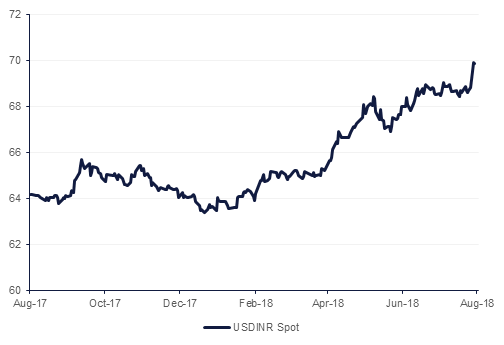
Germany reported stronger-than-expected GDP growth of 0.5% in Q2 and revised the Q1 estimate upwards from 0.3% to 0.4% which provided reassurance that the softness in Q1 was mainly due to temporary factors that have not been sustained. Domestic demand contributed positively to growth, with both household spending and investment increasing while net trade detracted from growth. In addition, July final CPI was confirmed at 2% y/y. What’s more, the German ZEW measure of investor sentiment rose sharply, from -24.7 in July to -13.7 in August, with the ZEW institute reporting that the increase was due to the easing of trade tensions between the US and EU.
In the wider Euro area, revised data suggests that growth in the Q2 remained steady at 0.4% q/q, contrasting the preliminary flash estimate of GDP that showed a slowdown in Q2. Economy in the region is likely to have grown at 2.3% y/y compared with 2.1% recorded in Q1 and unemployment appears to have fallen to 8.3% at the end of Q2.
Latest employment data out of the UK showed that the economy added 42k new jobs in June compared with 137k in the previous month. Though unemployment rate was pushed down to 4.0%, its lowest since 1975, the headline wage growth fell for the second month in a row, from 2.5% to 2.4% – and is now roughly in line with the current rate of CPI inflation.
India’s trade deficit in July widened to the most in more than five years, reaching $18 billion compared with $16.6 billion in the previous month, mainly as a result of higher oil import bill. According to the oil ministry, every rupee change in the exchange rate against the U.S. dollar impacts India’s crude-oil import bill by 108.8 billion rupees ($1.58 billion). The weakening rupee poses an inflation risk which had shown signs of easing after the RBI’s two rate hikes since June.
 Source: Emirates NBD Research
Source: Emirates NBD Research
Treasuries closed lower across the curve as receding safe haven bid caused yields on USTs to rise. Yields on the 2y, 5y and 10y USTs closed at 2.63% (+2 bps), 2.77% (+2 bps) and 2.90% (+2 bps) respectively.
Regional bonds continued to trade in a tight range as investors avoid taking fresh positions ahead of the week-long holiday in the region next week. The YTW on the Bloomberg Barclays GCC Credit and High Yield index closed at 4.49% and credit spreads tightened slightly to 175 bps as real estate names in the region reported good 1H results.
Despite upward revisions to Q2 2018 GDP, EURUSD hit the lowest levels since July 2017 on Tuesday as concerns over the threats of Turkey’s crisis posed to European financial institutions weighed on the common currency. This morning EURUSD has declined an additional 0.20% to 1.1324.
Elsewhere GBPUSD is trading below the 1.27 handle despite the UK’s unemployment rate falling to the lowest level in four decades. Market concerns over a no-deal Brexit in March 2019 are pressuring the pound. British foreign Secretary Hunt said that the risk of a no-deal Brexit was increasing and added that everyone needed to be prepared for a “chaotic atmosphere” should this be the outcome.
Developed market equities took a breather yesterday from the recent sell-off with the S&P 500 index adding +0.6% and the Euro Stoxx 50 index closing flat. However, no concrete progress was made towards resolving the concerns in Turkey.
Regional equities closed mixed with the DFM index losing -0.2% and the Tadawul adding +0.3%. Emaar Properties dropped -0.4% even as the company reported a 16% rise in Q2 2018 net profit. Drake & Scull added +1.3% after the company appointed a new CEO and said it was working on a new restructuring plan.
Oil markets whipsawed in a choppy day of trading yesterday. After spending part of the day up more than 1.8% Brent futures eventually closed down 0.2% at USD 72.46/b while WTI ended the down a similar amount at USD 67.04/b. the catalyst for the downward move appears to have been a surprise build in US inventories according to private sector data. API data showed a build of 3.7m bbl last week. EIA data is expected out later today with the market estimating a drop of 2.5m bbl.
The decline in front month futures helped to weaken forward curves further with the contango in 1-2 month Brent hovering just above USD 0.4/b while the backwardation in WTI is holding on just below USD 0.7/b. In longer spreads, particularly the Dec 18-19 in both contracts, there is a sustained weakening that has been in place since mid-June. The concerns over emerging market growth centred on Turkey will be weighing on risk assets for the near term but we do not see them as a direct threat to oil market fundamentals at present.